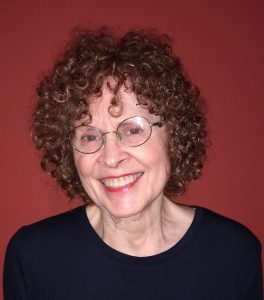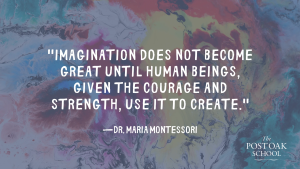 I am Georgie Ann Daub-Grosse. I am the creator of the content found in this website. The Montessori Art Mentor (MAM) Curriculum was developed over the 33 years of teaching art to children in the Cincinnati Public School system’s alternative Montessori program designed by Dr. Nancy McCormick Rambusch. This story could only have taken place in Cincinnati Ohio.
I am Georgie Ann Daub-Grosse. I am the creator of the content found in this website. The Montessori Art Mentor (MAM) Curriculum was developed over the 33 years of teaching art to children in the Cincinnati Public School system’s alternative Montessori program designed by Dr. Nancy McCormick Rambusch. This story could only have taken place in Cincinnati Ohio.
I went to Fairview Elementary school which was part of the Cincinnati Public School System. By the fifth grade, I had decided to become a teacher. While I was an eight grader at Hughes High School, my father went to all my teachers and asked what my strengths and weaknesses were. With his gathered information, he and my art teacher decided I would excel at teaching art.
I knew that I would only need to generate the money necessary for tuition, books and materials because I would be living with my parents. I was a babysitter until I was sixteen when I got a part-time job. When I graduated from high school I received a full two year Scholarship to the University of Cincinnati. After that, I continued to receive small scholarships, used my saved money and took out small student loans in order to finish school.
After graduation, I was hired by the Cincinnati Public Schools to teach in a junior high school. I learned that first year that I did not enjoy teaching, nor did I know enough about art or about children. I was forced to stop teaching in the middle of my second year because I was having problems with my pregnancy. I had time to think about what I wanted to do after the baby was born. My husband and I decided I would go back to school to get a Masters degree in drawing and painting. The University of Cincinnati and the Cincinnati Art Museum School of Art (Art Academy) collaborated in designing the graduate program I attended on a full two year scholarship.
During my second year in graduate school, my husband decided to leave the corporate world and to accept a teaching position in the Business College at Xavier University in Cincinnati, Ohio. He was advised to investigate the Montessori Lab School by a fellow professor. I met with Hilda Rothschild to talk with her about the program. She began her explanation by showing me the environment used by the children. I told her how surprised I was to find that three years old students were introduced to very complex art concepts. She asked me to explain what I meant. I gave her at least five lessons using the Montessori Sensorial materials.
I learned two things that day. One, I wanted to put our child in the program when he was three. Two, I wanted to learn the program just for myself. That spring, I was invited to observe each week in Mrs. Rothschild’s working environment at the Cincinnati Country Day School. In early June that year, I graduated from the University of Cincinnati with a Masters in Fine Art, and in late June started Montessori training at Xavier. That fall I taught as an adjunct instructor at the University of Cincinnati and continued my Montessori program. I never intended to be a Montessori teacher but I did use the method with my older students. My husband gave me a budget and storage space for the materials I was making for my non-existent classroom.
I was part of a three man painting exhibition at the College of Mount Saint Joseph. The head of the art department was helping me to hang my paintings. When asked about Montessori Education, I told her it was the best method for teaching art. She asked me to build an environment for the two weeks she would be teaching a class about alternative methods for teaching art that summer. I borrowed Montessori materials and shelving from my friends and used the materials I had made. I photographed the entire project. The Sister’s students came and observed the children working. One adult came almost every day to work in the environment. The Sister’s students said they didn’t see how it would work in a regular school.
I became head of household at the death of my husband. The only way I wanted to earn a living was as a Montessori art teacher. I went back to Xavier and finished my degree. There were no Montessori schools large enough to support an art teacher so I decided to create a Children’s Studio in my own neighborhood. I had to learn to write grants and approach non-profit organizations for funds. It took seven different organizations to fund the project which was part of an effort to establish a grassroots community center. I had enough money for my salary, an assistant’s salary and the rest of the environment. I designed my own shelving, chose all the rest of the furniture, learning materials, art materials and supplies. I had an overhead projector, slide projector, and video equipment. In the morning hours I was the administrator of the program and head janitor. In the early afternoon I taught four and five year olds and in the late afternoon hours I taught the six to nine year olds. The children had to live in the neighborhood. I made one mistake. I could have made time for the neighborhood 9-12s who hung around outside my door interested in what we were doing. I did not know they would have liked it even though it was not intellectually as advanced as they would need.
When I approached an organization for funds I always told them that I would make every effort to institutionalize my program. While I was teaching in the Children’s Studio I continued to look for funding. I went to the head of art education for the State of Ohio. I arrived at his office at ten in the morning with slides, a projector and written material. I left that afternoon at five. He said he would write a recommendation for my program and made the following suggestions. I was to make a proposal for funding to the Martha Holden Jennings Foundation. I was also to get a recommendation from the president of the National Art Education Association. He would write an introductory letter to the man. I was asked to give two presentations at the national conference that year in Chicago. On the strength of the reports made by his representatives, the President of the Association gave my program his support.
I made my proposal and received a lovely letter saying the Jennings Foundation would like to grant my request provided I could do my work in a public school system. It was their conviction that innovation would only be effective if it happened within a public school. At that point I did not know what to do next. Fortunately, it was taken care of for me.
Less than a month later, the head of Research and Development for the Cincinnati Public Schools called me and asked me to meet with his department to talk about grant writing. The system was developing a series of alternative schools to ease the pressure caused by bussed integration and needed to write grants. I told him of the grant I had and the stipulation as to how it must be used. He had a fortuitous idea of how to use the grant. The Children’s Studio was located in Mt. Adams. The Creative and Performing Arts School was to be located in the Mt. Adams school building. There were, however, two groups of children that would stay in the building, one was a kindergarten class and the other was a group of first through third graders. The next year I taught the kindergarten children with their teacher for ninety minutes every morning. We would walk them down to the school together. I would spend the afternoon in the studio with the elementary children. They were divided into two groups to meet the needs of the traditional teacher. I escorted each group to and from the main building. I was called the Pied Piper of Mt. Adams.
During that year I was interviewed in the Children’s Studio environment by Dr. Nancy McCormick Rambusch. She asked me to report to the personnel department downtown to be interviewed and hired to teach art in the new Montessori Alternative School she was designing.
The Creative and Performing Arts School moved to a different building at the end of the school year. The first Public Montessori School moved into the vacated Mt. Adams School building along with my environment.

